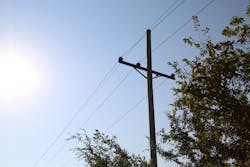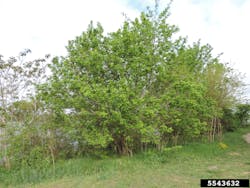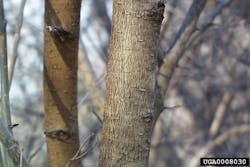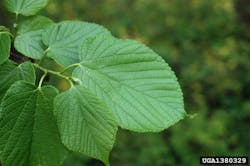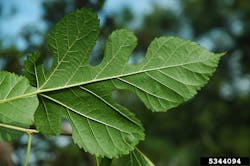Why Mulberry Trees Are a Problem
As a deciduous species capable of thriving in a variety of well-drained soil types (including sandy, clay and loam), mulberry trees (Morus spp.) can be found in each of the lower 48 states (except Nevada) — especially in mild, subtropical and tropical climates. In addition to being recognized by their unique foliage and wide diameter, mulberry trees often invade forest edges or open areas, leading to the displacement of low-growing native plant communities that can otherwise safeguard the integrity of adjacent utility infrastructure.
What Do Mulberry Trees Look Like?
Three primary variations of mulberry trees can be found throughout the United States: red (Morus rubra), white (Morus alba) and black (Morus nigra). These trees feature short, crooked trunks with ridged bark that is light tan when they are young and turns to golden brown as they mature. While each species can grow anywhere from 20 to 40 feet wide, their heights can help you identify one from the others. Red mulberry is the tallest, growing up to 80 feet tall. Comparatively, white mulberry grows up to 60 feet tall, and black mulberry rarely exceeds 30 feet in height.
Two of the easiest ways to identify mulberry trees are to examine their fruit and leaves. In the spring, mulberry fruit will appear green, white or pale yellow with clusters of tiny fruits, each of which contain a seed. As the fruit ripens, it will turn pinkish red before turning dark purple or black. When ripe, mulberry fruit will measure approximately 1 inch long and possess a blackberry-like appearance.
Mulberry trees also are polymorphic, meaning they can feature up to three different leaf shapes on a single branch. Most leaves are oval- or glove-shaped with up to three lobes. Regardless of shape, all mulberry leaves are glossy and light or dark green with serrated edges. The following characteristics can be used to distinguish one species of mulberry from the next:
- Red mulberry: Rough leaves that measure 3” to 9” long and feature pointed lobes
- White mulberry: Smooth leaves that measure 5” to 7” long and feature rounded lobes
- Black mulberry: Leaves measure 3” to 5” long and are heart-shaped at the base
How to Control Mulberry Trees Effectively
Seeds within the fruit of these perennial trees are commonly consumed by birds, who facilitate propagation by digesting and randomly depositing the seeds. This makes it difficult to anticipate mulberry development. As these trees can grow up to 2 feet each year, it’s important to control them while they grow — before they create issues for your program, the public, and the land you manage.
Using selective herbicide applications as part of an Integrated Vegetation Management (IVM) strategy can improve results achieved by mechanical mowing, leading to sustainable control and fewer maintenance requirements. Before spraying, be sure to match your equipment and delivery rate of your spray nozzles with the height and density of the trees you target.
For example, tall and dense brush commonly requires the use of a truck-mounted spray gun with spray tips that deliver up to 2 gallons per minute at 40 to 60 psi. Comparatively, backpack sprayers with spray tips that deliver less than 1 gallon of spray per minute are often appropriate for treating shorter brush with low-to-moderate density.
- High-volume Foliar Application
Use Garlon® 4 Ultra herbicide from Corteva Agriscience at a rate of 2 to 6 quarts per 100 gallons of spray mixture. Apply the mixture sufficiently to all leaves, stems and root collars at a volume of 100 to 400 gallons of total spray per acre, depending on the size and density of trees on your treatment site.
To minimize spray drift, select a minimum spray pressure that provides adequate coverage without forming a mist. Directed sprays should reach no higher than the tops of targeted trees.
- Low-volume Foliar Application
Mix up to 5% v/v of Garlon 4 Ultra herbicide in water and apply 10 to 100 gallons of finished spray. Use a sufficient spray volume to ensure uniform coverage on targeted trees, ensuring all areas are sprayed, including foliage, stems and root collars. For optimum results, add a surfactant to the spray mixture. Tank-mixing up to 9 quarts of Garlon 4 Ultra with labeled rates of Tordon® 22K herbicide in 10 to 100 gallons of finished spray also can broaden the spectrum of control. Always check product labels to confirm state registrations.
- Chemical Side-trimming
If you wish to only control portions of trees that pose a threat to interfere with overhead powerlines, chemical-side trimming applications are a fantastic option. Direct a spray solution of 2.85 ounces of TerraVue® herbicide per acre to cover only the portions of mulberry trees you wish to control. TerraVue also can be tank-mixed with other labeled herbicides for chemical limb-trimming applications. To prevent inadvertent control of the entire tree, avoid spraying the mulberry crown.
- Dormant-season Treatments
After mulberry leaves have fallen off later in the year, a number of dormant-season applications can be used to control mulberry trees. One option is the frill or girdle method. Make a single girdle through the bark along the circumference of the tree at a convenient height and wet the cut surface with an undiluted or diluted solution containing Vastlan® herbicide from Corteva. The frill should allow for the herbicide to remain next to the inner stem and absorb into the tree.
Vastlan herbicide also can be used for the tree injector method. To execute this strategy, completely surround the tree at a convenient height with injections through the bark at intervals of 3 to 4 inches between the centers of each injector wound. Use either 0.5 milliliter of undiluted Vastlan herbicide or 1 milliliter of a diluted solution for this method.
Lastly, you can cut the tree down and spray or paint the cut surface with undiluted Vastlan herbicide. When using this cut-stump treatment, be sure to adequately wet the cambium area next to the bark.
To learn more about the benefits dormant-season treatments can provide to your program, electrical transmission reliability and your bottom line, click here. Otherwise, more information regarding best practices for controlling incompatible vegetation throughout utility rights-of-way and adjacent land can be found at Utility.VegetationMgmt.com.
™ ® Trademarks of Corteva Agriscience and its affiliated companies. Tordon 22K is a Restricted Use Pesticide. Under normal field conditions, TerraVue® is nonvolatile. TerraVue has no grazing or haying restrictions for any class of livestock, including lactating dairy cows, horses (including lactating mares) and meat animals prior to slaughter. Label precautions apply to forage treated with TerraVue and to manure and urine from animals that have consumed treated forage. TerraVue and Vastlan® are not registered for sale or use in all states. Contact your state pesticide regulatory agency to determine if a product is registered for sale or use in your state. Consult the label for full details. State restrictions on the sale and use of Garlon® 4 Ultra apply. Consult the label before purchase or use for full details. Always read and follow label directions. © 2023 Corteva.
Sponsored By:
